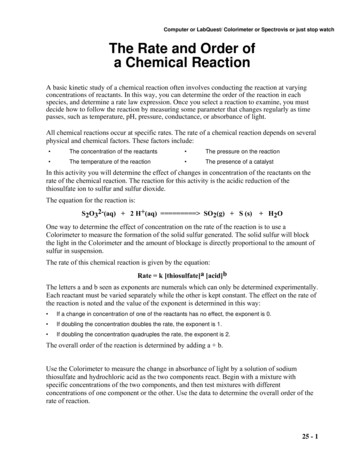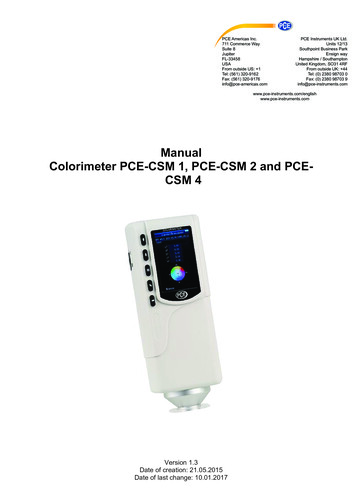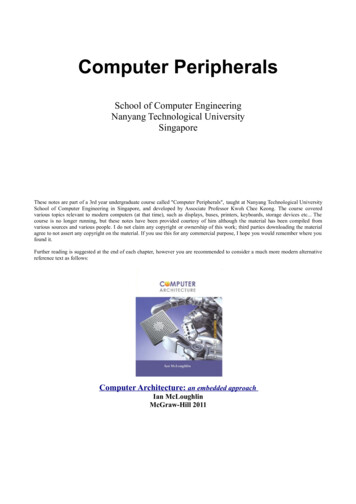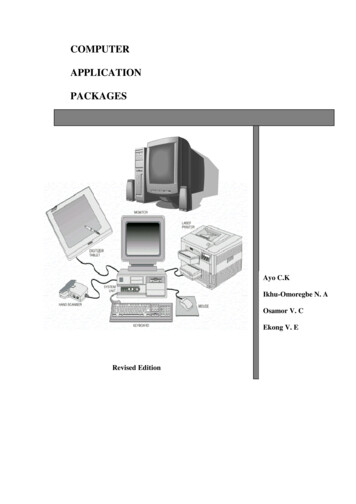
Transcription
Computer or LabQuest/ Colorimeter or Spectrovis or just stop watchThe Rate and Order ofa Chemical ReactionA basic kinetic study of a chemical reaction often involves conducting the reaction at varyingconcentrations of reactants. In this way, you can determine the order of the reaction in eachspecies, and determine a rate law expression. Once you select a reaction to examine, you mustdecide how to follow the reaction by measuring some parameter that changes regularly as timepasses, such as temperature, pH, pressure, conductance, or absorbance of light.All chemical reactions occur at specific rates. The rate of a chemical reaction depends on severalphysical and chemical factors. These factors include: The concentration of the reactants The pressure on the reaction The temperature of the reaction The presence of a catalystIn this activity you will determine the effect of changes in concentration of the reactants on therate of the chemical reaction. The reaction for this activity is the acidic reduction of thethiosulfate ion to sulfur and sulfur dioxide.The equation for the reaction is:S2O32-(aq) 2 H (aq) SO2(g) S (s) H2OOne way to determine the effect of concentration on the rate of the reaction is to use aColorimeter to measure the formation of the solid sulfur generated. The solid sulfur will blockthe light in the Colorimeter and the amount of blockage is directly proportional to the amount ofsulfur in suspension.The rate of this chemical reaction is given by the equation:Rate k [thiosulfate]a [acid]bThe letters a and b seen as exponents are numerals which can only be determined experimentally.Each reactant must be varied separately while the other is kept constant. The effect on the rate ofthe reaction is noted and the value of the exponent is determined in this way: If a change in concentration of one of the reactants has no effect, the exponent is 0. If doubling the concentration doubles the rate, the exponent is 1. If doubling the concentration quadruples the rate, the exponent is 2.The overall order of the reaction is determined by adding a b.Use the Colorimeter to measure the change in absorbance of light by a solution of sodiumthiosulfate and hydrochloric acid as the two components react. Begin with a mixture withspecific concentrations of the two components, and then test mixtures with differentconcentrations of one component or the other. Use the data to determine the overall order of therate of reaction.25 - 1
Kinetics AnalysisAs this reaction proceeds, it undergoes a change that can be precisely measured by a VernierColorimeter (see Figure 1). By carefully varying the concentrations of the reactants, you willdetermine the effect each reactant has on the rate of the reaction, and consequently the order ofthe reaction. From this information, you will write a rate law expression for the reaction.OBJECTIVESIn this experiment, you will Conduct the reaction using various concentrations of reactants.Determine the order of the reaction .Determine the rate law expression for the reaction.Figure 1MATERIALSVernier computer interfaceComputer or Lab QuestVernier Colorimeter or Spectrovisor orstopwatch1 cuvettes3 – Syringe pipettes25 - 2Hydrochloric acid, 6 molarSodium thiosulfate, 0.24 molarDistilled WaterCotton Swab
The Rate and Order of a Chemical ReactionPROCEDURE1. Obtain and wear goggles.2. Connect a Colorimeter to Channel 1 of the Vernier computer interface. Connect the interfaceto the computer with the proper cable.The Colorimeter analyzes colors of light that pass through a solution. The solution is put intoa rectangular container called a cuvette, which is then placed inside the Colorimeter. Themeasure of the amount of light that passes through a solution is called “transmittance”.Transmittance is a ratio of the intensity of the transmitted light to the intensity of the originallight, and is usually expressed as a percentage.3. Start the Logger Pro program on your computer. Open the file “25 Rate and Order” from theAdvanced Chemistry with Vernier folder. Clickthe experiment tab and select data collection.Adjust the data collection to .2 samples/secondand click done.4. Set up and calibrate the Colorimeter.a. Prepare a blank by filling an empty cuvette¾ full with distilled water. Place the blank inthe cuvette slot of the Colorimeter and closethe lid.b. If your Colorimeter has a CAL button, set thewavelength on the Colorimeter to Red nm,press the CAL button.5. Conduct the reactions according to the chartbelow. Use micro pipets to measure out thevolumes of reactants and distilled water intosmall labeled breakers. Add the distilled waterto the acid solution, to standardize your process. Place the two reactants in separate labeledbeakers.Note: If a spectrovis is used instead of the colorimeter with a LabQuest.Connect the spectrovis to the LabQuest. Change the mode to time based.Tap the orange bar and select wavelength and set to 635 nm.Tap the orange bar again to Calibrate the spectrometer.a. Fill a blank cuvette ¾ full with the distilled water blank.b. Place the cuvette in the spectrometer. Be certain to align the cuvette so that the clearsides are facing the light bulb icon and arrow on the spectrometer. To correctly use acuvette, remember: All cuvettes should be wiped clean and dry on the outside with a lint-free tissue. Always position the cuvette with the clear sides or reference point facing thewhite reference mark on the top of the spectrophotometer. Handle cuvettes only by the top edge of the ribbed sides. All solutions should be free of bubbles.25 - 3
Kinetics Analysisc. The Tap the Orange box and select Calibrate. The following message appears in theCalibrate dialog box: “Waiting seconds for lamp to warm up.” After the allotted time,the message changes to: “Finish Calibration.”6.Prepare for Trial 1 and collect absorbance data.An alternate method is to place a line on a white back ground the width of the bottom of the microsyringe. Determine the time with a timer the length of time it takes to longer you are able toview the black line do to the colloidal sulfur.The general procedure is as follows:a) Measure the water needed for each trial and the acid place into one cuvette.b) Place the cuvette into the spectrovis or colorimeter or on white paper.c) Add the required thiosulfate to the same cuvette .d) Quickly close the top and record the absorption readings.TABLE #1. A Kinetics Study of the Thiosulfate-HCl ReactionBATrialmls0.24 MNa2S2O3mls6.0 .80.401.607.Clickto begin collecting absorbance data. Data will be gathered for 200 sec. If you areusing stop watch determine the time it takes for you not to be able to see the black line youhave written on the white back ground. This time is your time interval.8. When the data collection is complete, carefully remove the cuvette from the Colorimeter.Clean the cuvette with the cotton swab provided. Remove all colloidal sulfur. Rinse andclean the cuvette for the next trial.25 - 4
The Rate and Order of a Chemical Reaction9. Examine the graph of the first trial. Select alinear region of the graph that covers about 2040 seconds of the reaction. Click the LinearRegression button, . Record the slope, as theinitial rate of the Trial 1 reaction, in your datatable. Determine the time the linear regionbegan and when it ended. This time interval istime of reaction. Use the last point highlightedas your time interval.10. Repeat Steps 6-9 to conduct Trials 2-6.QUESTIONS AND CALCULATIONS:Q1. Complete Table #2 by determining rate of the reaction for each trial. WhereFor each trial, calculate the concentration of the diluted Thiosulfate solution.For each trial, calculate the concentration of the diluted Hydrochloric acid.Q2. (a) Plot the molar concentration of the thiosulfate, [S2O32-], for trial 2 through 6 as a function of thetime of the reaction.(b) Plot the natural log of the molar concentration of the thiosulfate ion, ln [S2O32-], as a function ofthe time of the reaction.(c) Plot the reciprocal of the molar concentration of the thiosulfate ion, 1/ [S2O32-], as a function ofthe time of the reaction.(d) Determine the slope of the graph plotted in questions Q2a, Q2b, or Q2c, which produced a linearrelationship. The slope of your graph is equal to the rate constant, k, for the reaction.(e) From the type of graph which produced a linear relationship in questions Q2a, Q2b, or Q2c,predict the "order" of the reaction with respect to the molar concentration of thiosulfate, [S2O32-]Information PlottedReaction Orderconcentration vs timezero orderln concentration vs timefirst order1/concentration.vs timesecond orderQ3. (a) Calculate the ratio of the concentrations of thiosulfate ion in wells 2 &6. Likewise, calculate theratio of the concentrations of HCl in wells 2 &1(b) Calculate the ratio of the rates of the reaction between the solutions in wells 2 &6. Likewise,calculate the ratio of the rates of the reaction between solutions in wells 2 & 1.25 - 5
Kinetics Analysis(c) Determine the exponents in the rate equation for the reaction between sodium thiosulfate andhydrochloric acid where, the exponents x and y are determined by comparing the ratios of themolar concentration of the reactants to the ratio of the rates of reaction in the same trials.Use the Average Rate and then the Graphical Rate.By comparing the ratios of the concentrations calculated in Q3a with the ratio of their ratescalculated in Q3b, you can determine the "order" of the reaction. For example, if the ratio of theconcentrations is 2 and the ratio of the rates is also 2, then the reaction is first order (2) 1 2.However, if the ratio of the concentrations is 2 and the ratio of the rates is 4 (2)2, then thereaction is a second order reaction. Likewise, if the ratio of the concentrations is 2 and the ratioof the rates is roughly 1, then the reaction is a "0" order reaction (a change in concentration haslittle or no effect on the rate of the reaction).(d) Determine the rate constant, k, in the rate equation for each trial in Table #2 and calculate theaverage rate constant of all trials.(e) Give your rate equation or rate law complete with your value of the rate constant, k.(f) What is the overall order of the reaction? (The overall order of the reaction is the sum of theexponents, x and y.)Q4. Determine the "half life", t½, of the thiosulfate ion in an acid medium from the order of the reactionand the table below:Q5. According to your data, what general statement can you make regarding the effect of theconcentration of thiosulfate ion, [S2O32-], on the rate or speed at which the colloidal sulfur is formed?Q6. According to your data, what general statement can you make regarding the effect of theconcentration of hydrochloric acid, [HCl], on the rate or speed at which the colloidal sulfur isformed?Q7. Compare the "order" and rate constant of the reaction determined graphically with the "order" andrate constant you determined algebraically. Which method, the graphic method or the algebraicmethod, do you feel is more reliable? Justify your answer.25 - 6
The Rate and Order of a Chemical ReactionAverage Rate Constant k 25 - 7
Note: If a spectrovis is used instead of the colorimeter with a LabQuest. Connect the spectrovis to the LabQuest. Change the mode to time based. Tap the orange bar and select wavelength and set to 635 nm. Tap the orange bar again to Calibrate the spectrometer. a. Fill a blank cuvette ¾ full with the distilled water blank. b.










